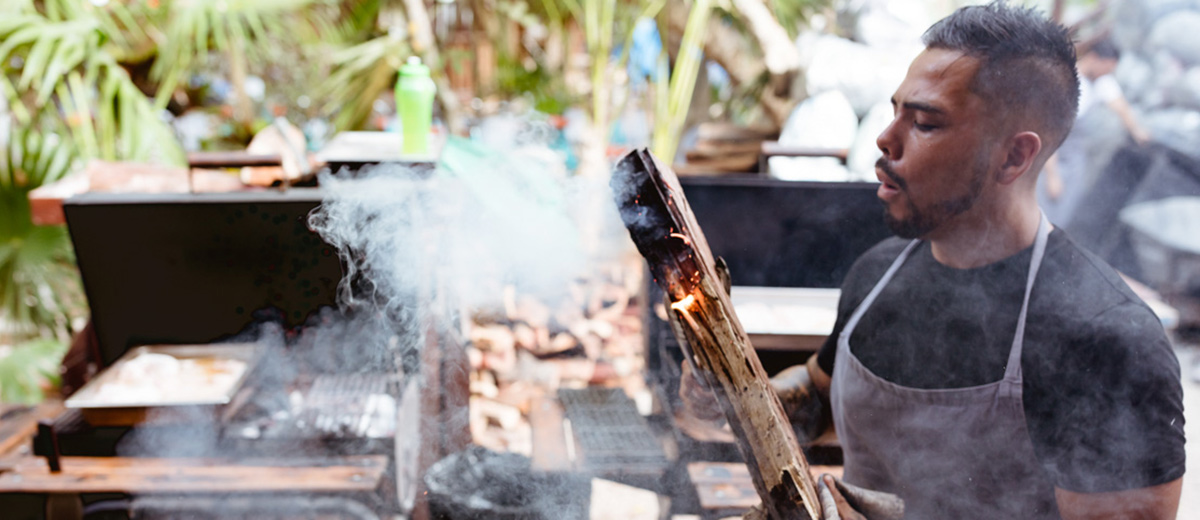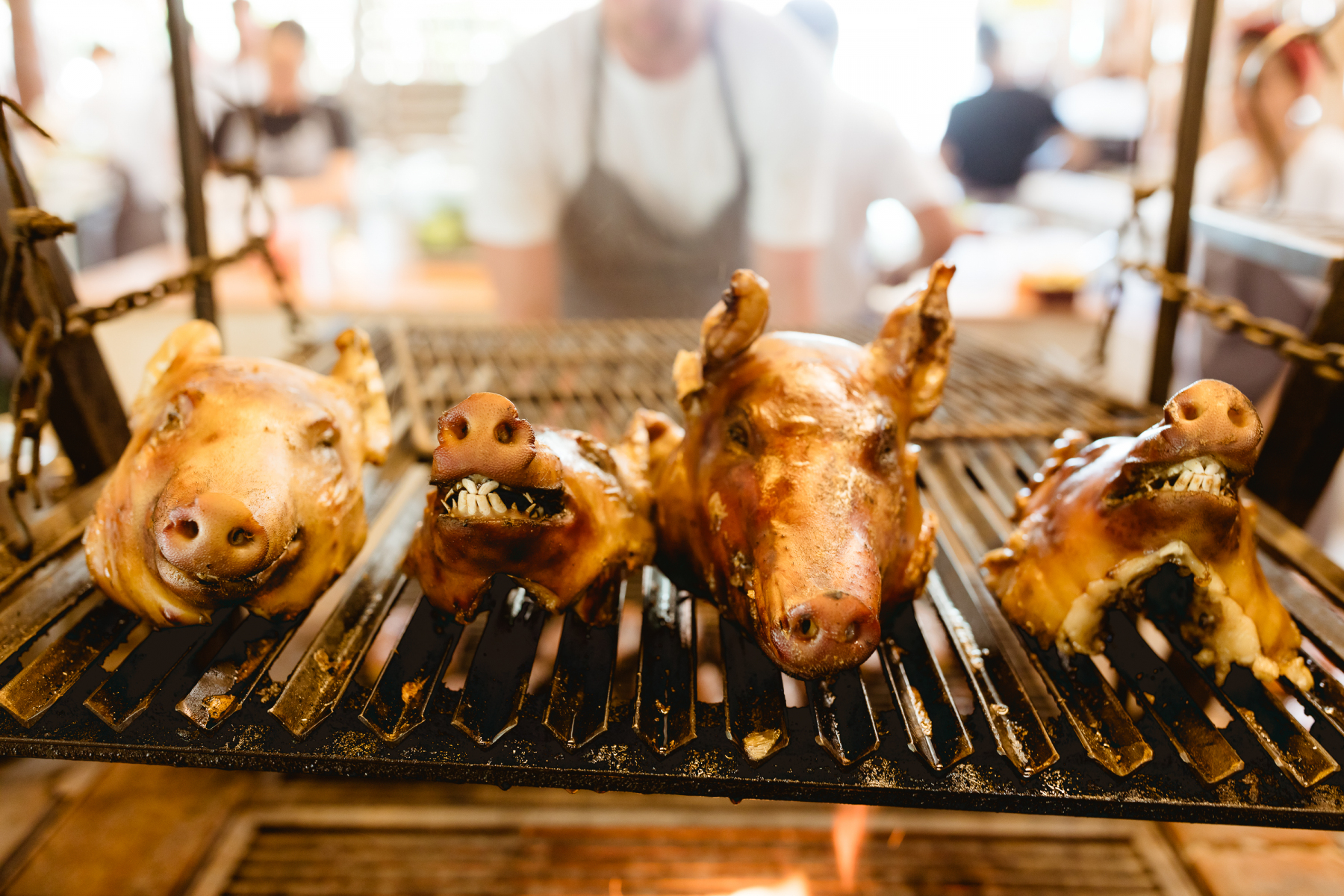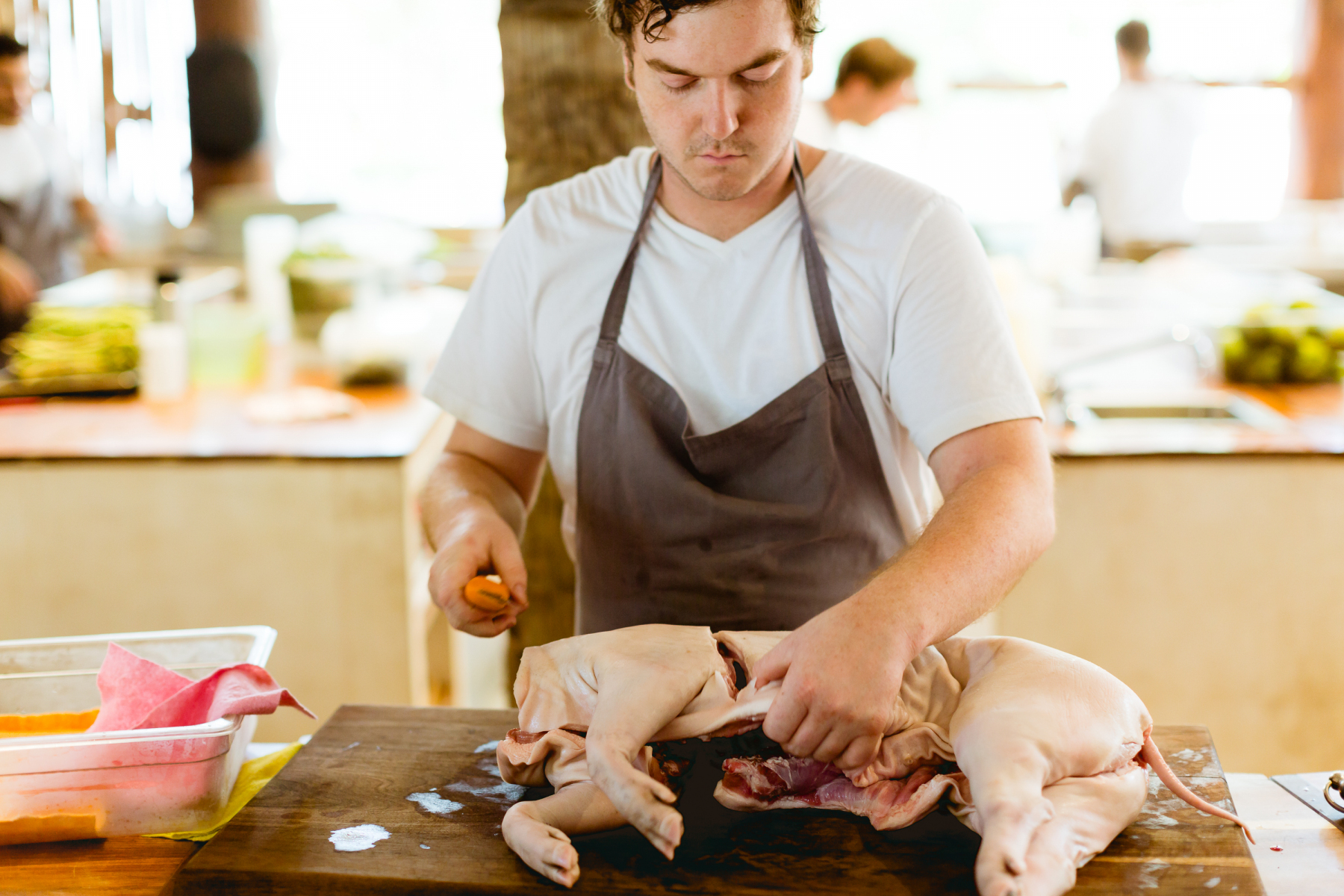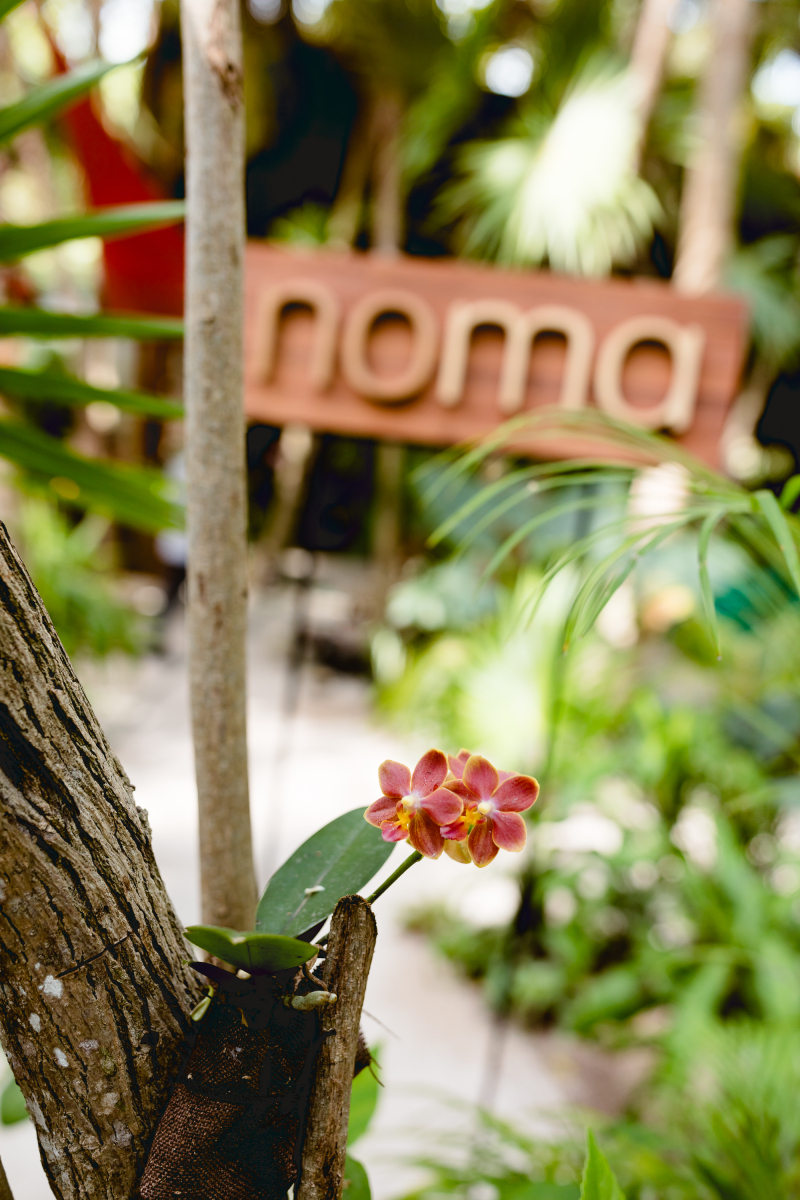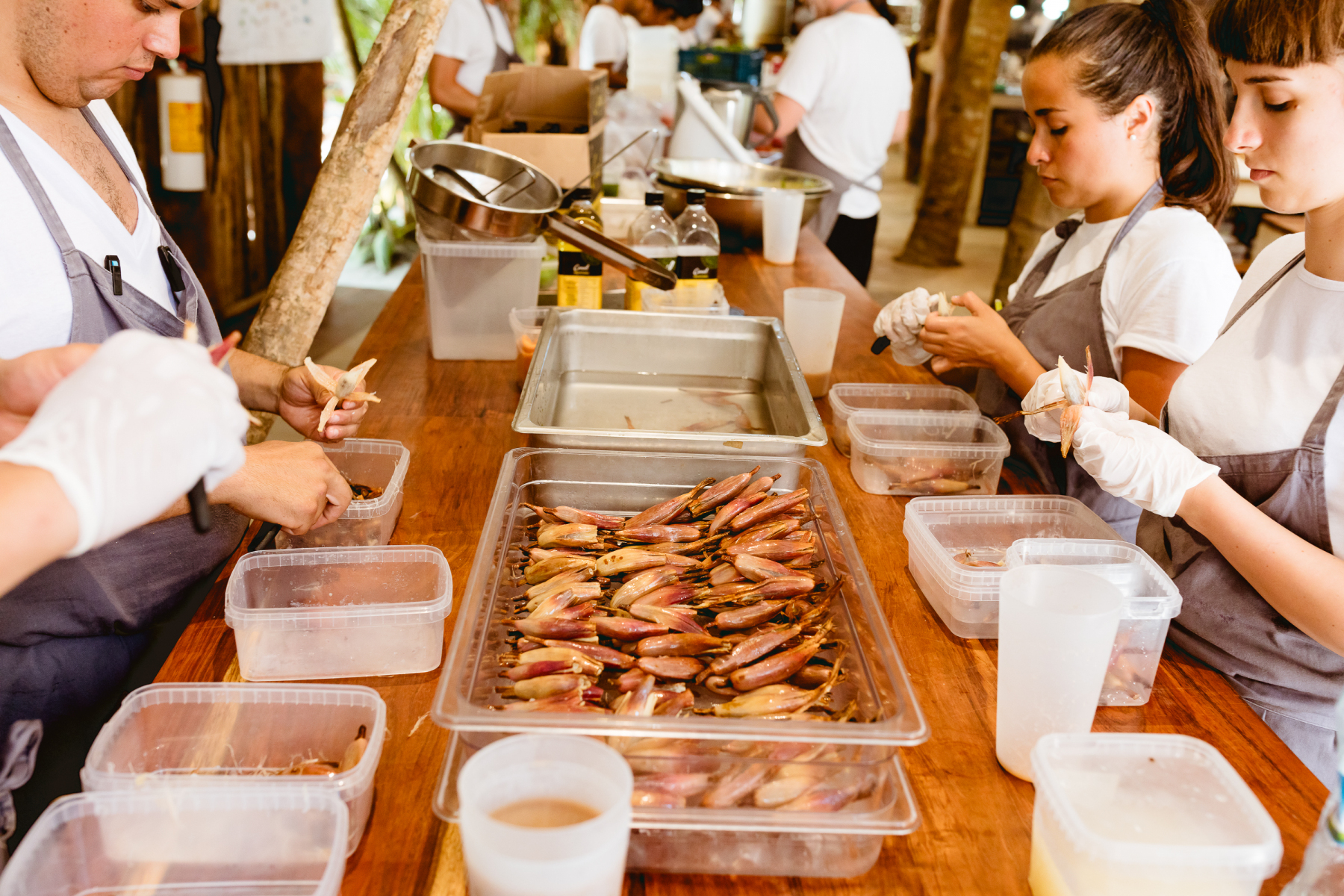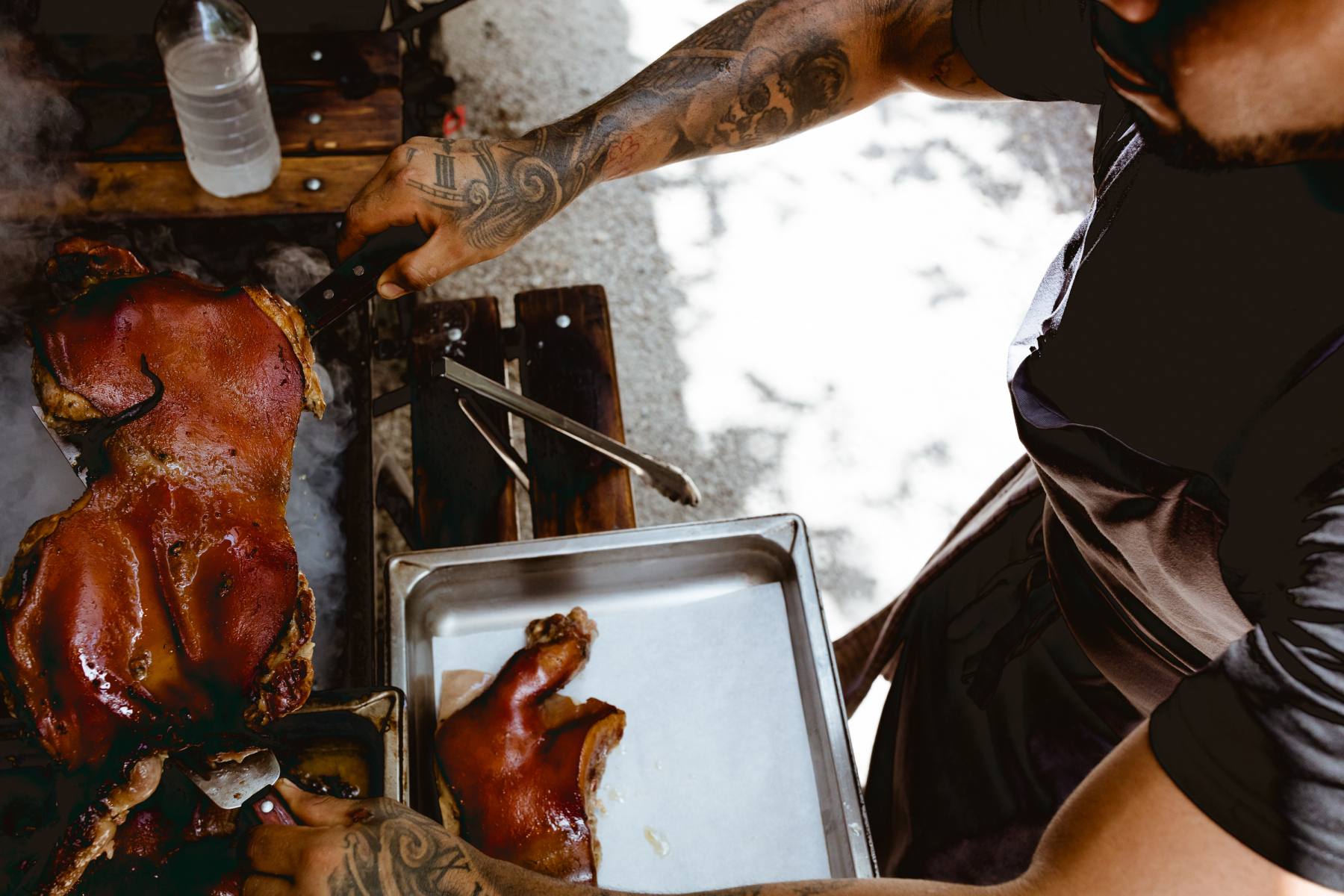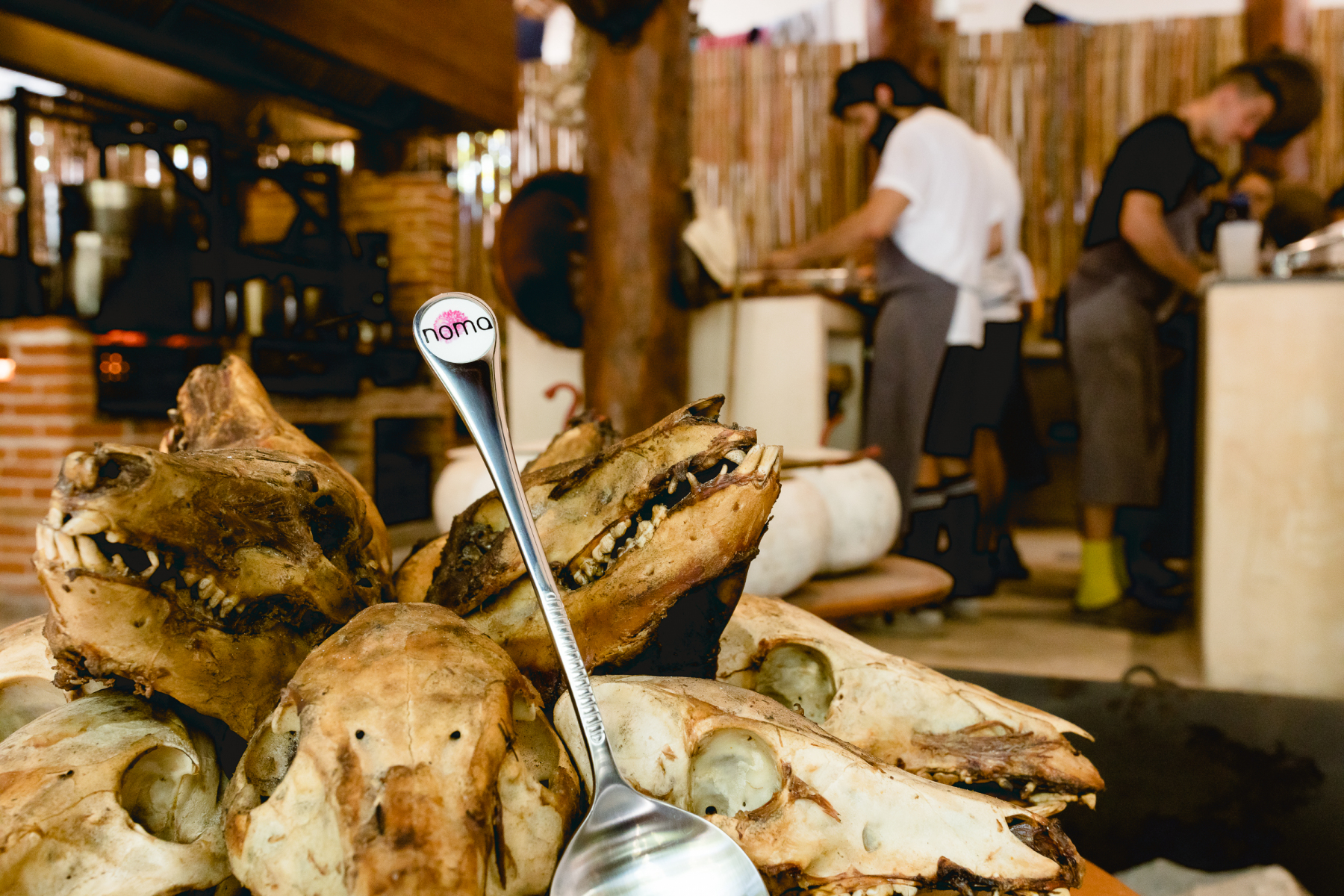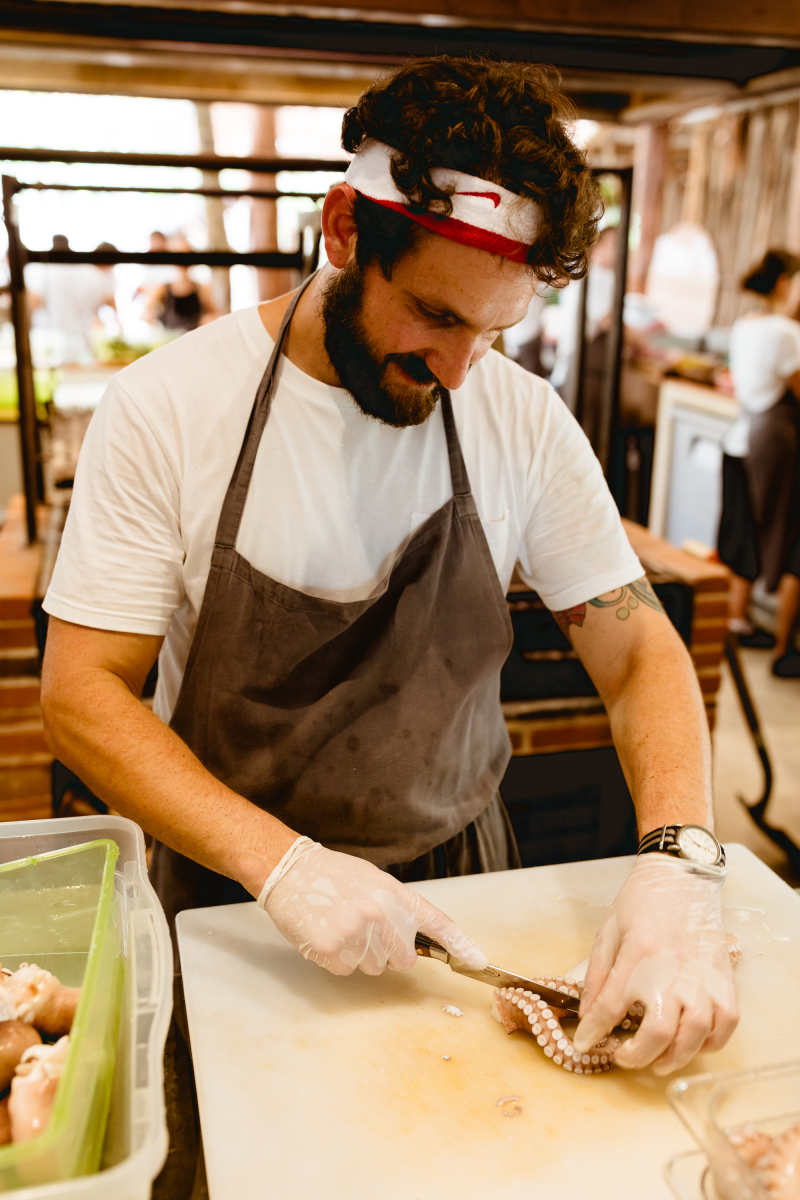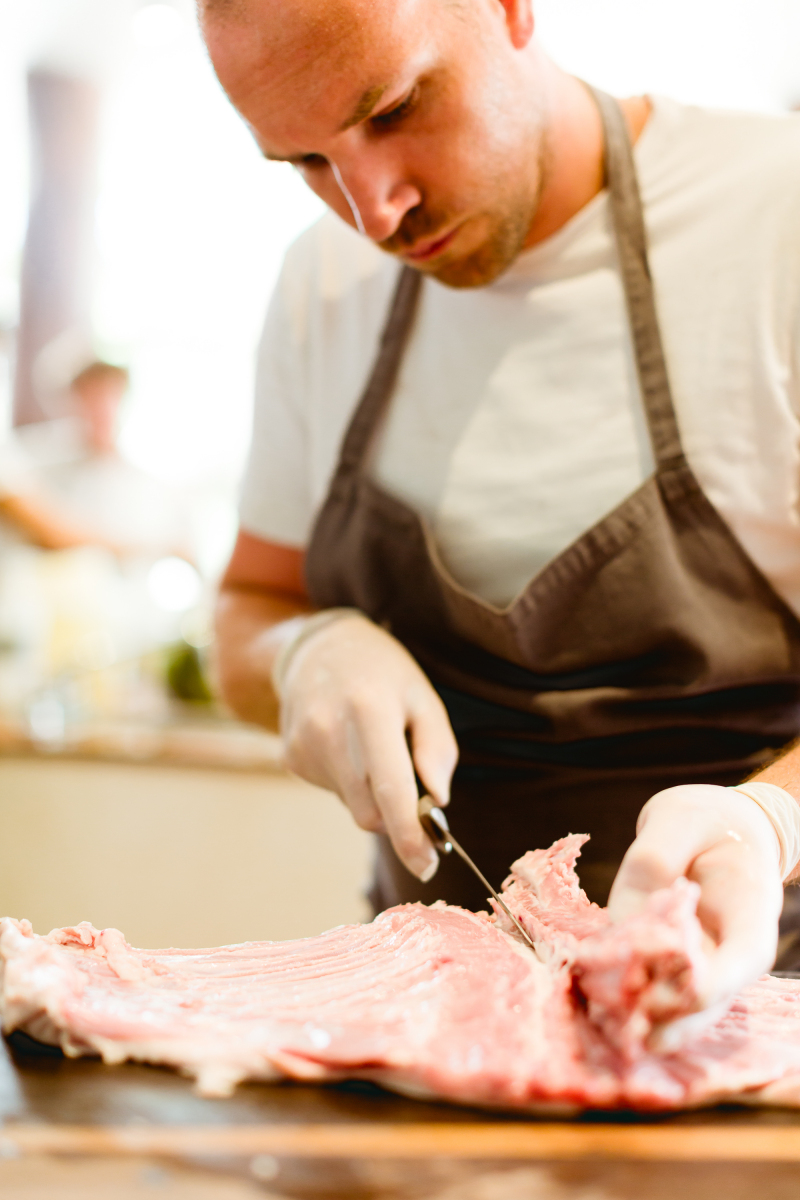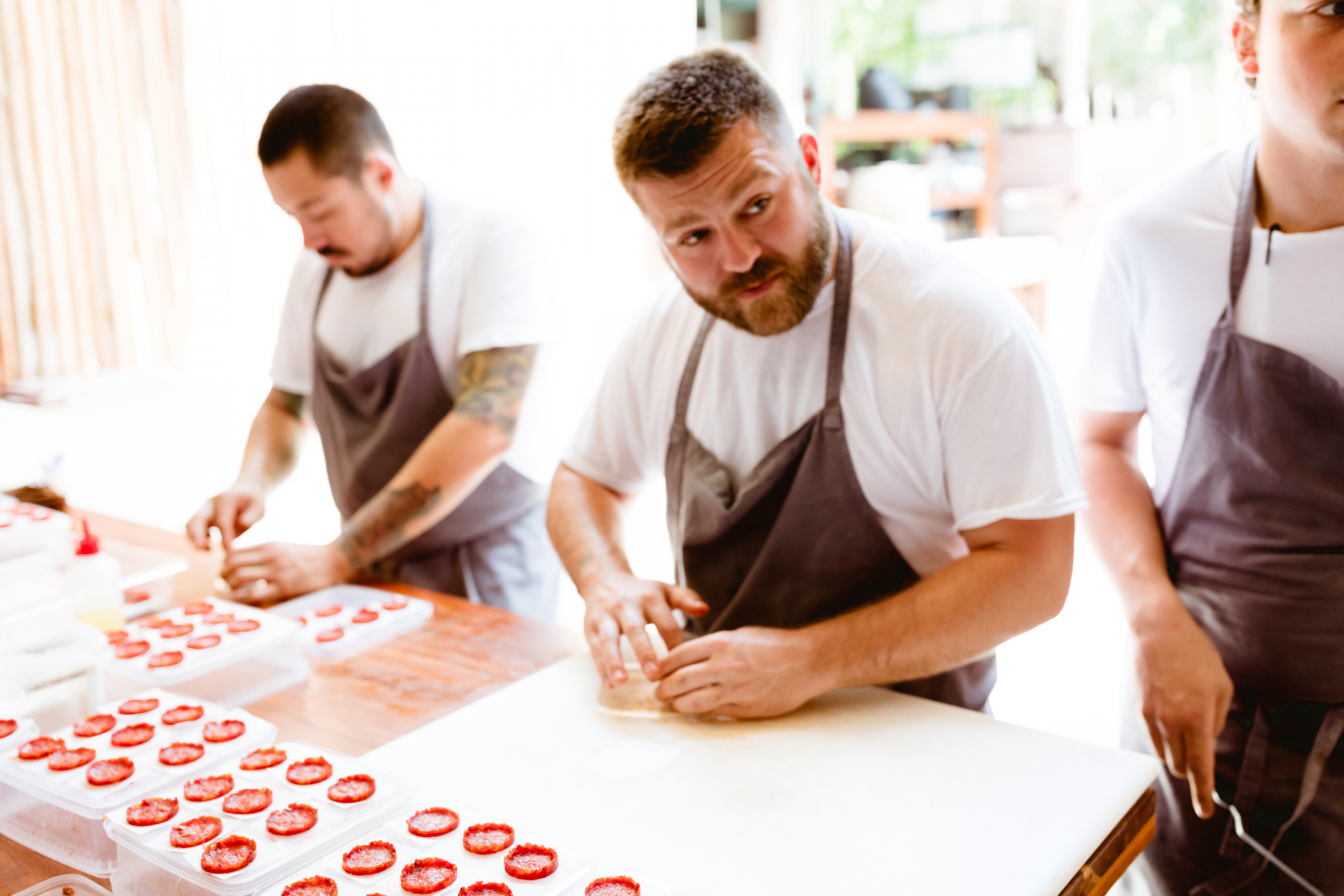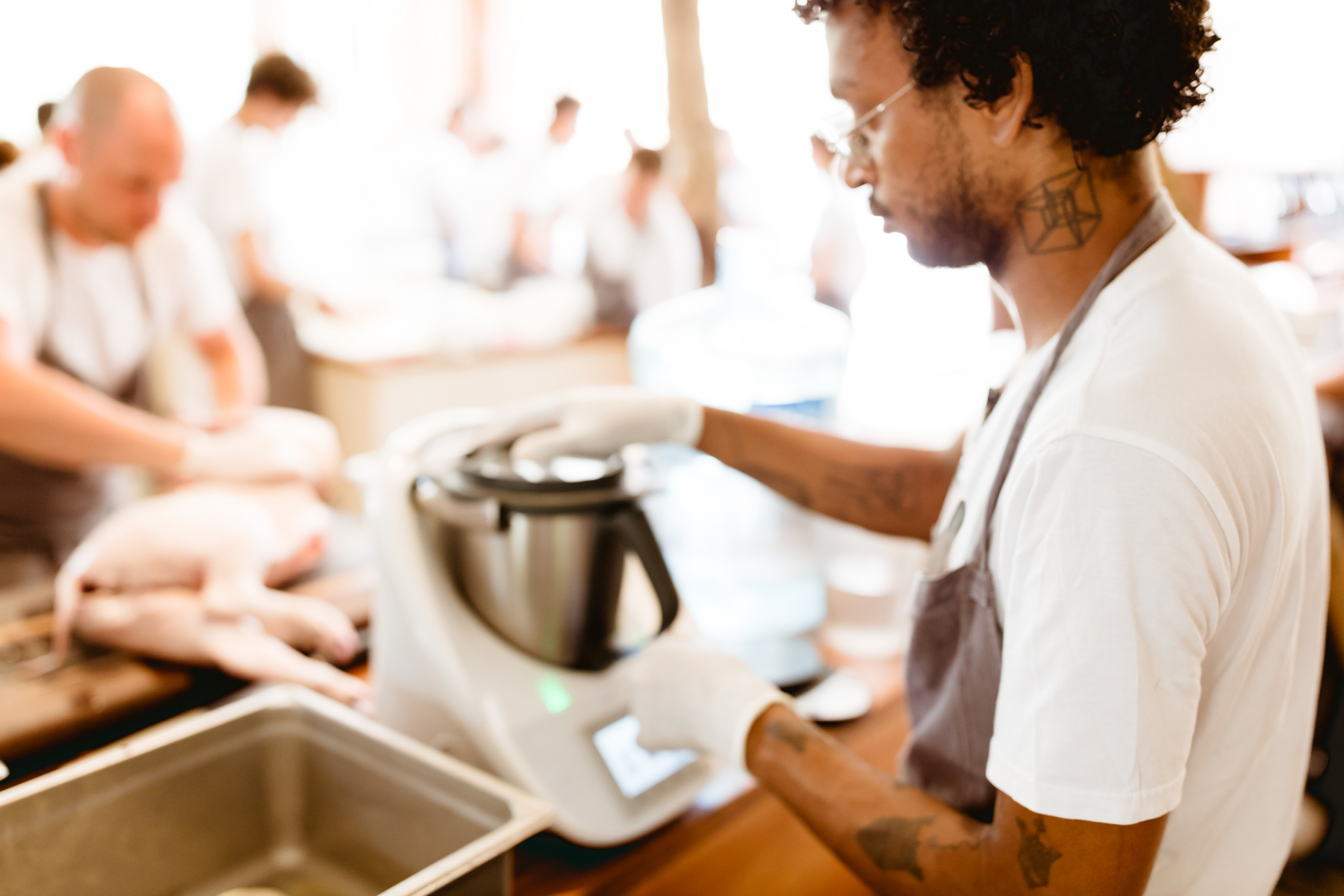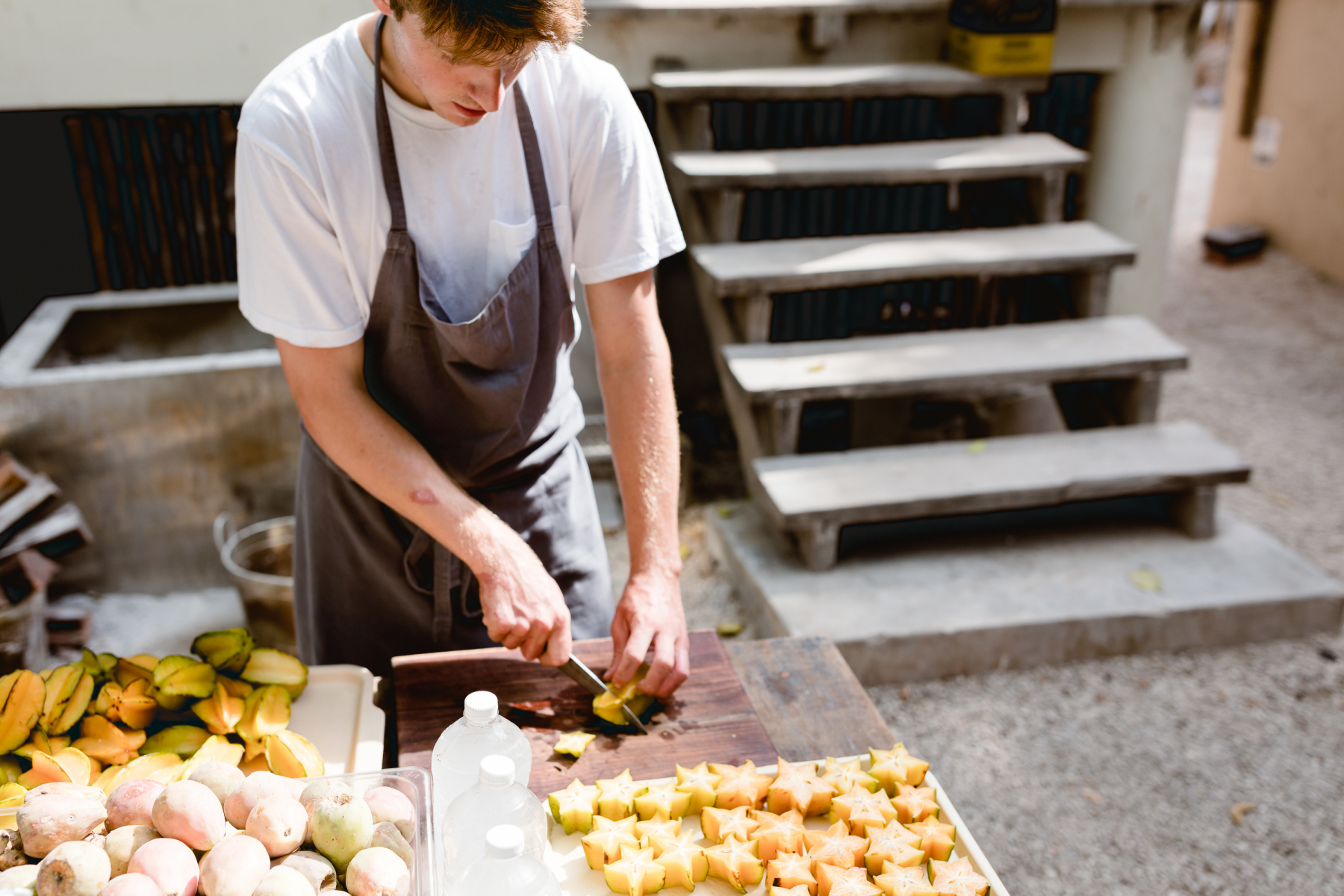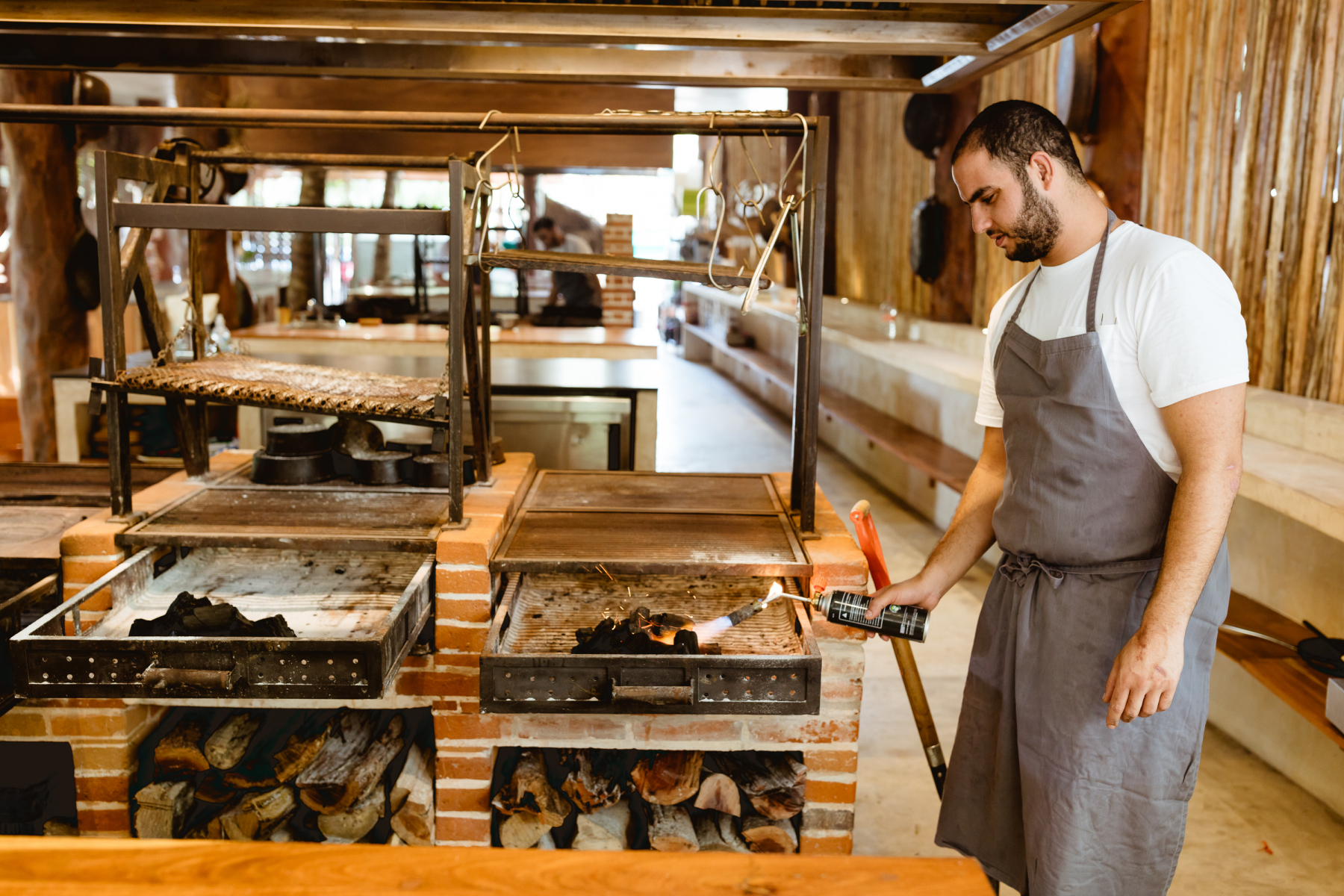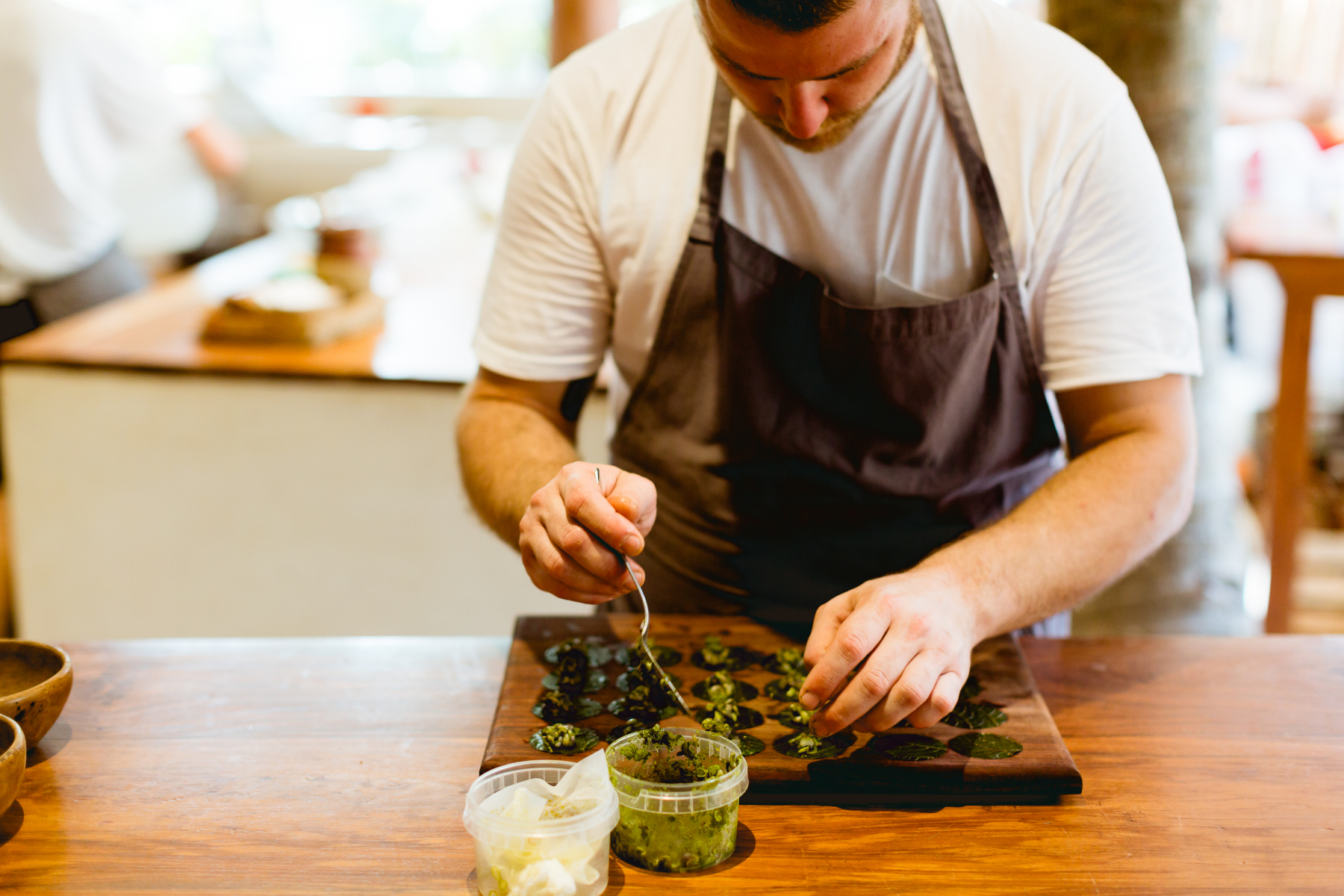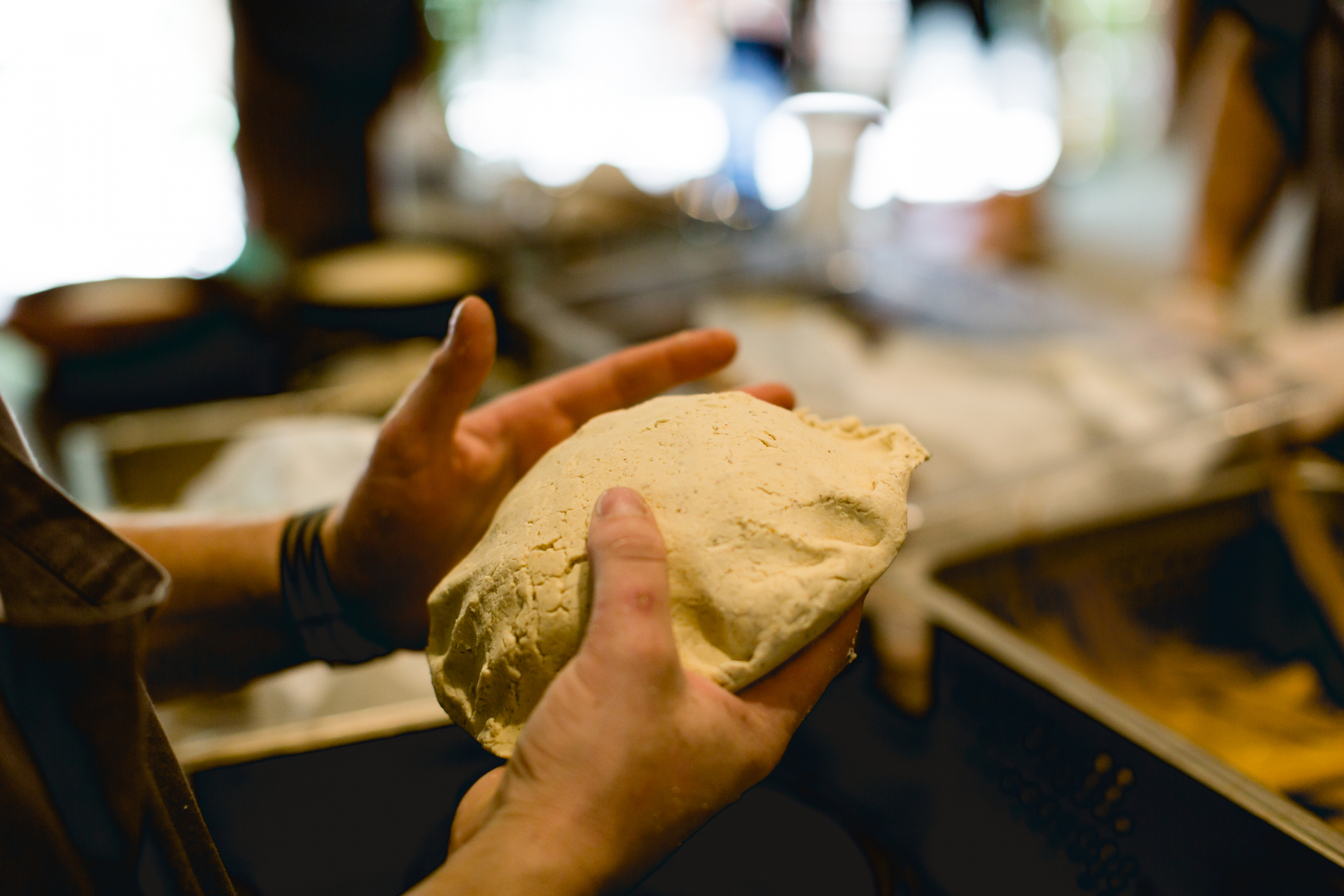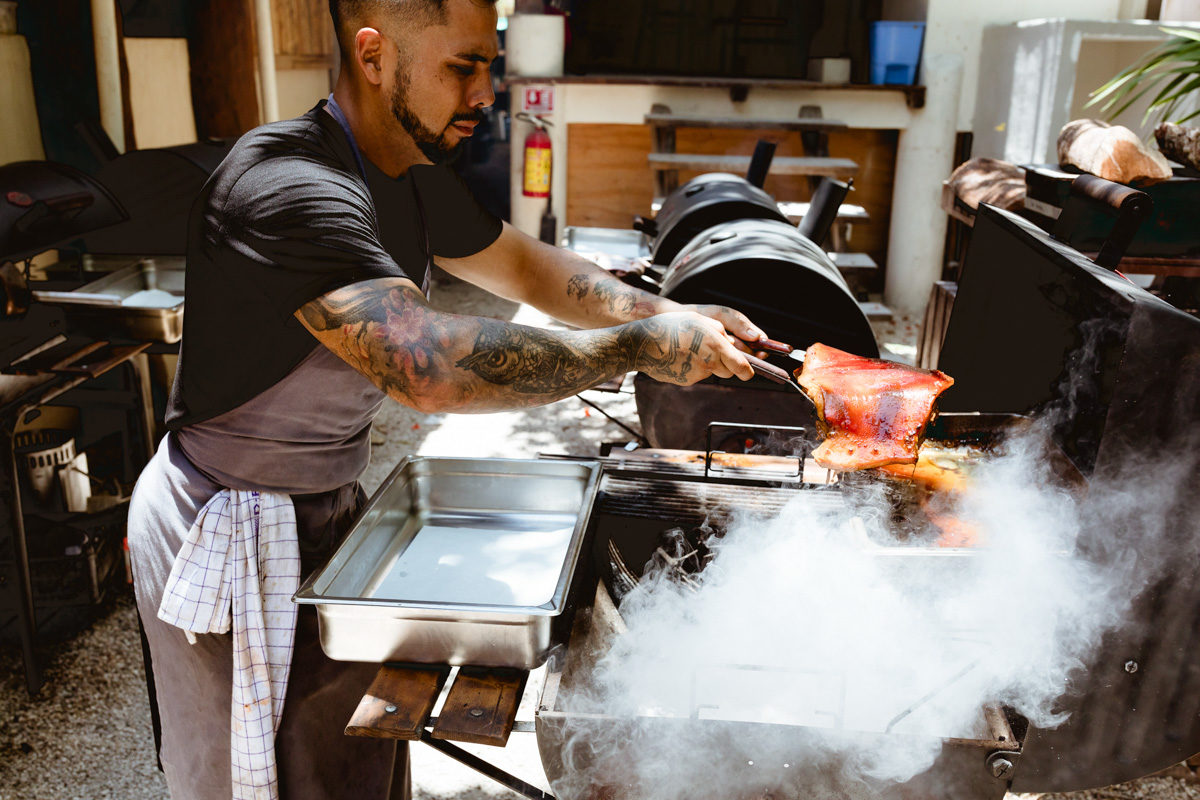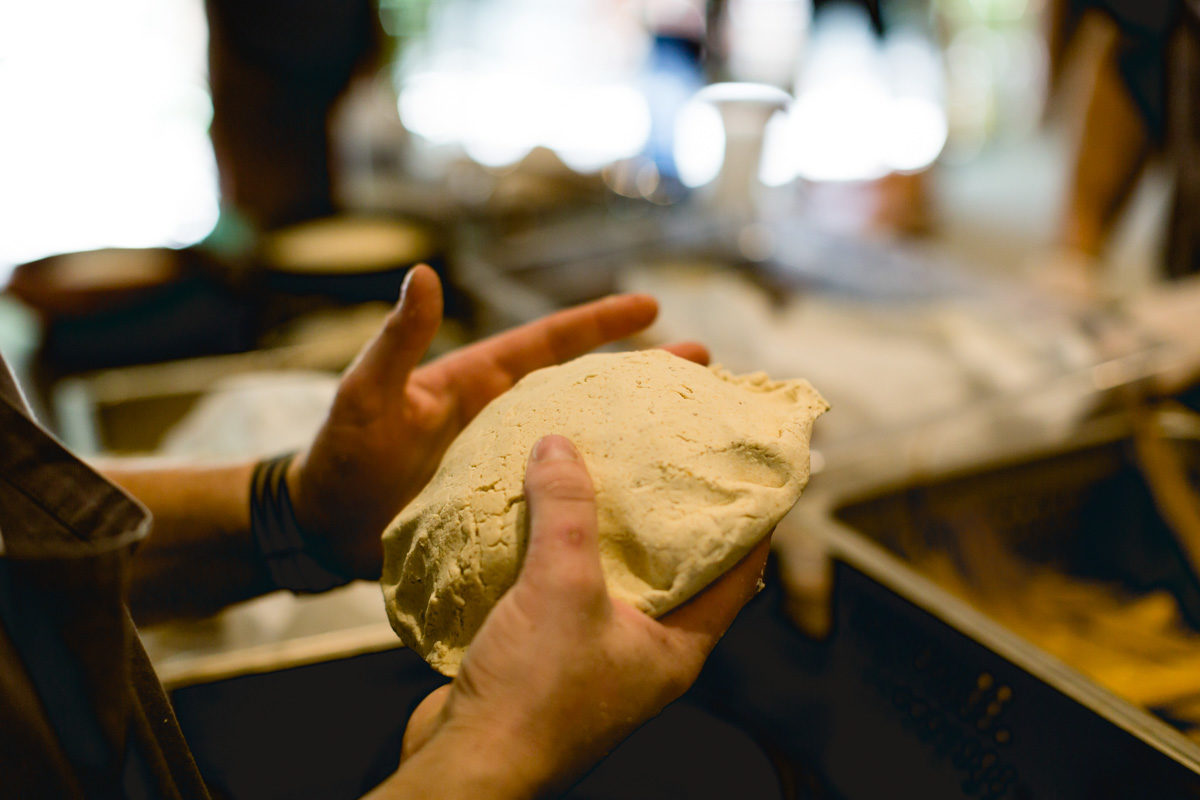In November 2016, René Redzepi dropped the news that Tulum in Mexico’s Quintana Roo would be the location for his third ever Noma pop-up. The $600 tickets sold out in a matter of three hours when they went on sale.
We were lucky to score a ticket and experience the unique immersive pop-up not just from a diner’s perspective, but also behind the scenes where the REAL magic happens – in the kitchen.
We are beyond thrilled to take you behind the scenes in our “Tales from Tulum” series, as we interview a few of the Noma Chefs and team members that made Noma Tulum happen.
First up is Jose Luis Hinostroza. A Southern California native and graduate of the San Diego Culinary Institute, Jose Luis Hinostroza’s passion for cooking has taken him all over the world – from Alinea in Chicago to El Celler de Can Roca in Girona, Spain and Maaemo in Oslo, Norway – learning from some of the best Chefs along the way.
Jose Luis had been working with René for 2 years in Copenhagen and served as one of the R&D Chefs in the Noma Tulum Team. From testing dishes to sourcing indigenous ingredients, he takes us deep into what it took for Noma Tulum to achieve its success.
Photos by Jaime Fritsch.
How was your experience being part of the R&D team for Noma’s pop up in Tulum, Mexico?
I grew up just like any Mexican kid, eating tacos and making tamales at home. But, even though I’ve always known my country was full of gems, I wasn’t expecting to be surprised. You grow up around the magic and are blindsided by all that it holds. For me, it took a Danish Chef to help me realize how blessed and proud I am to be a part of Mexico.
Being a part of the Noma Test Kitchen allowed me to do what so many chefs dream of doing – the opportunity to discover my own culture and roots through cooking. I had this opportunity all while working together with a talented and ambitious group of Chefs including: Head of R&D Thomas Frebel, Junichi Takahashi, Mette Brink Søberg, Rosio Sanchez, Nathanial French, Pablo Soto, and Gabe Erales.
What did the R&D process entail?
Testing and failing is the simplest way to describe the R&D process.
Here in Mexico we are lucky to have a wide range of climate regions: desert, semi-arid, Mediterranean, tropical, humid-subtropical, temperate etc. You could easily find four different types of coriander from different parts of the country that have slight taste variations. That being said, in a pop-up that represents Mexico, which coriander should represent the country?
Simple questions like this one came up all the time and this was just in regard to product selection; without getting into technique or menu development. We dived into the products by region, tasted and made a selection of what we were willing to showcase following what we considered the best of Mexico.
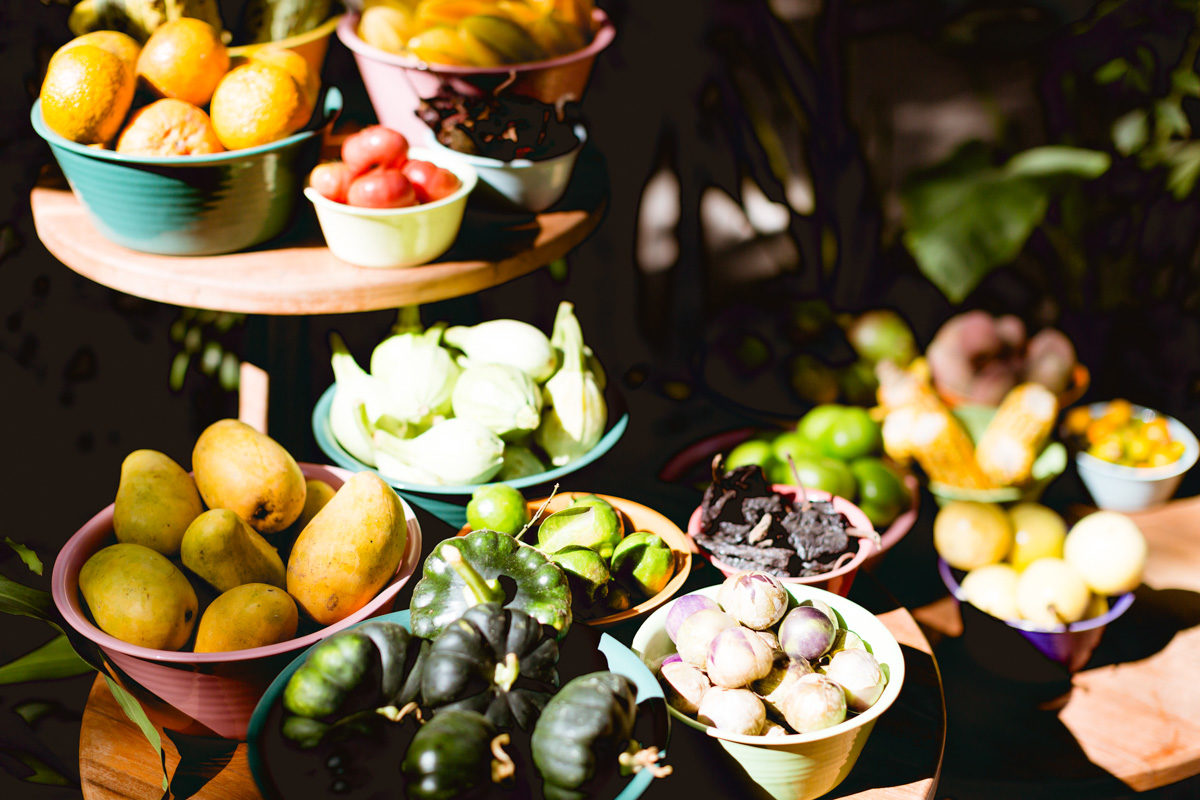
Another consideration was technique. With some ingredients, you may have an idea of what will work and what won’t. But, when you are introduced to product that you have never seen before, however, you really have to try everything to brainstorm how it can come into play in the menu by process of elimination.
Can it be turned into an oil? A paste? A vinegar? Can it be infused into a broth? Dried into a powder? Maybe grilled? Or smoked? Then you start to fail, and that’s when the interesting things start to happen. Through this process, you might end up with an amazing powder made from grilled banana skins, or an oil made from fresh avocado leaves, or a simple habanero vinegar.
From there, you have to ask, how can we use this? Where can we? With what can we? You start putting X, Y, and Z together, tasting, adding more of X, tasting again, taking more of Y out, having the whole team taste it, maybe it’s a dish that’s not going anywhere and should be abandoned or maybe it can be improved by cooking it longer or serving it colder: no variable is ever overlooked.
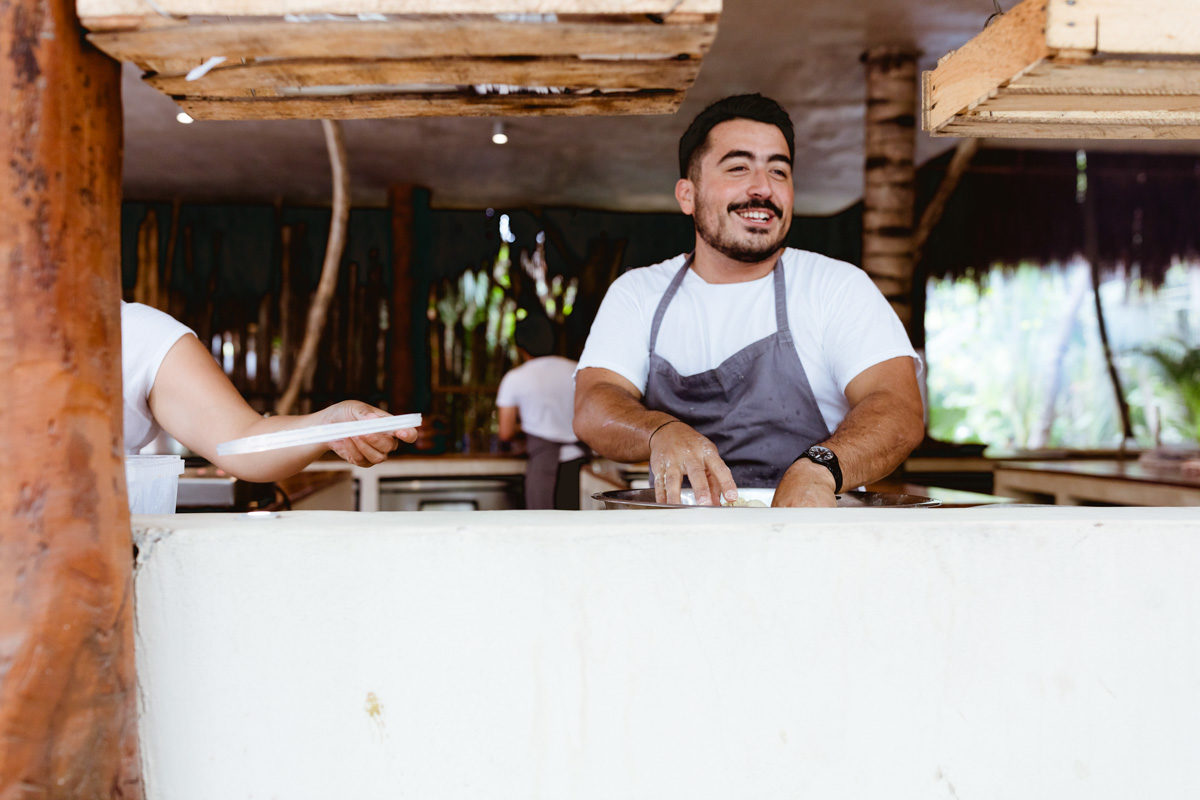
At this stage, the most important asset that you have is the team around you, that is putting their heads together to come up with a solution. Nine extremely ambitious and talented chefs from very different backgrounds and parts of the world are tasting and thinking – How can this dish be improved?
Without a doubt teamwork was the key to making the Noma Mexico menu a success. I learned so much just by seeing how the members of the team went about trying and failing.
How did you source ingredients and what kind of culinary infrastructure is in Tulum?
In a town like Tulum you really don’t have much infrastructure for sourcing product. I have come along some farmers in the area delivering good product, yet there are so few of them. We had to work extremely close with all our purveyors that it was as much as a learning process for them as it was for us. From picking and packaging to shipping and transporting.
We definitely couldn’t have formed these relationships without Santiago Lastra, our product manager, sacrificing his time in the kitchen to devote 100% of his time to sourcing all of the ingredients for the menu. Most people don’t understand this, but it’s not enough finding an amazing product, it’s also about getting it to the restaurant and in the quantities required. For most of the product that we were using, we were only able to get just what was needed for the event and the majority of the fresh produce was seeded and grown especially for us. Needless to say, this all took months of organization and preparation, from Santiago.
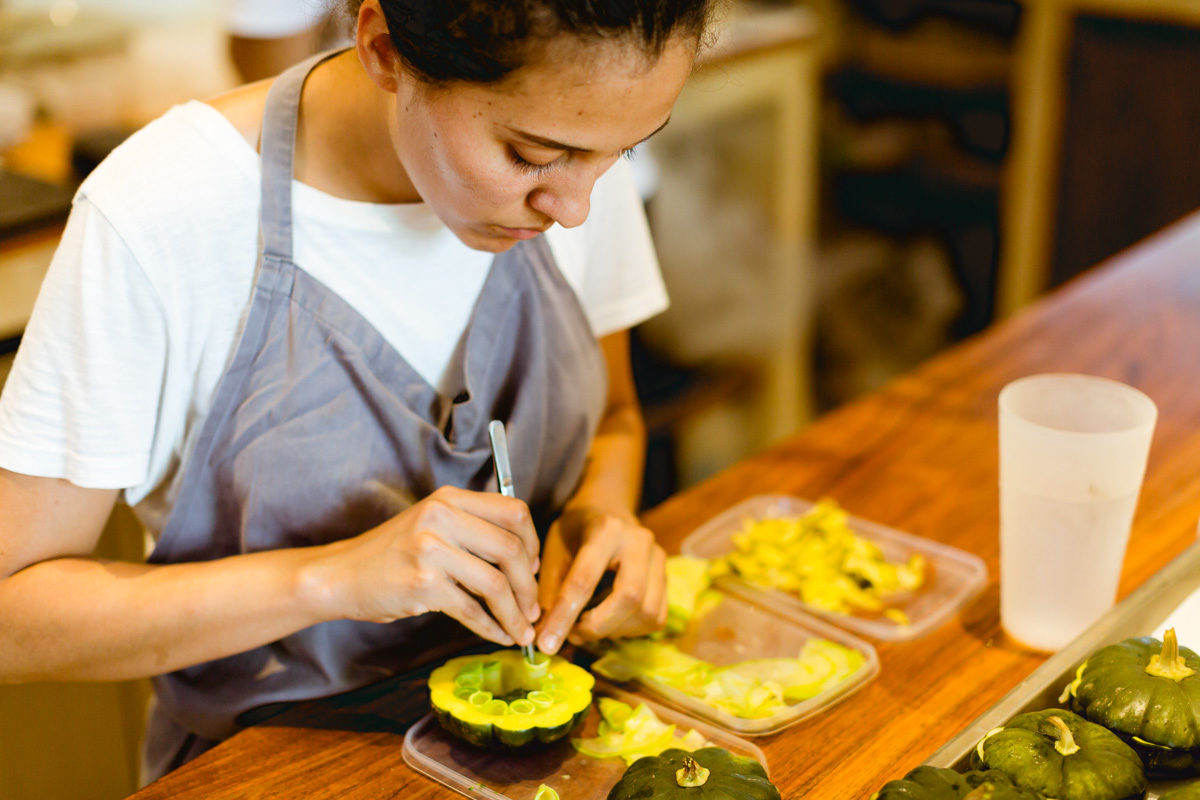
We also worked with an organization called Traspatio Maya, an NPO whose mission is to promote and commercialize the produce grown by Mayan communities all throughout the Yucatan Peninsula. Traspatio Maya introduced us to the Mayan women from Yaxunah responsible for preparing the corn, grinding it, and hand-making every single tortilla for Noma Mexico. The corn was a single-sourced variety also from their community – an endemic species called “naal teel”.
All together we worked with product from 14 different states in Mexico and well over 35+ purveyors. We had three people diving for melon clams in the Sea of Cortez, two foragers in the Yucatan peninsula collecting piñuelas (one of the most floral and sweet cactus fruits), and four people hand-picking all our tropical ingredients in Tabasco. Not to mention the continuous amount of mezcal producers and wine and beer makers from all across Mexico.
Tell us about how the restaurant was built from scratch.
If we had followed the same model as in Copenhagen, the first seating wouldn’t be done with desserts by the time the second seating started to get their first bites. The design of the kitchen, done by La Metropolitana in Mexico City, required the construction of an independent island per dish. So, 14 dishes meant 14 independent islands, each manned by 3-6 chefs. I am extremely gratified and thankful to the whole team at Colibri Boutique Hotels and to La Metropolitana for giving us the kitchen that we needed to perform without having any boundaries; without a doubt, the most beautiful kitchen I have ever worked in or seen.
Another major aspect that changed from our “normal” routine back home [in Copenhagen] was not having the benefit of electricity to cook – we only had access to fire. Cooking over fire is nothing new to the restaurant, in fact most of the ‘a la minute’ cooking in Copenhagen is done over fire anyways, but we wanted to challenge ourselves even more and cook completely over fire.
At the end, cooking this way made sense for the Noma Mexico philosophy. Grilling and cooking with fire is as essential to Mexican cuisine as fermenting is to Japanese cuisine. We used a mixture of charcoal and local woods to begin the fire. We started receiving a native red wood caled “zapote” in the restaurant, and we quickly noticed the amount of smoke it produced. Let’s just say we all had a couple of incidents with the zapote; by throwing a couple of those logs on the fire, some people almost got fired.
How many kitchen staff and stagiaires were there?
We were about 25 Chefs from Noma in Copenhagen, and about 20 ex-Noma stagiaires. The ex-stagiaires were cooks that wanted to experience the pop-up, and since they had already worked with us they could jump straight into it and help us teach others to execute the menu.
We had the pleasure of hosting 20 culinary students from different schools all throughout Mexico, which I feel was an amazing opportunity for them. I admit, I was a bit jealous of not having the opportunity of experiencing something like Noma Mexico when I was in culinary school.
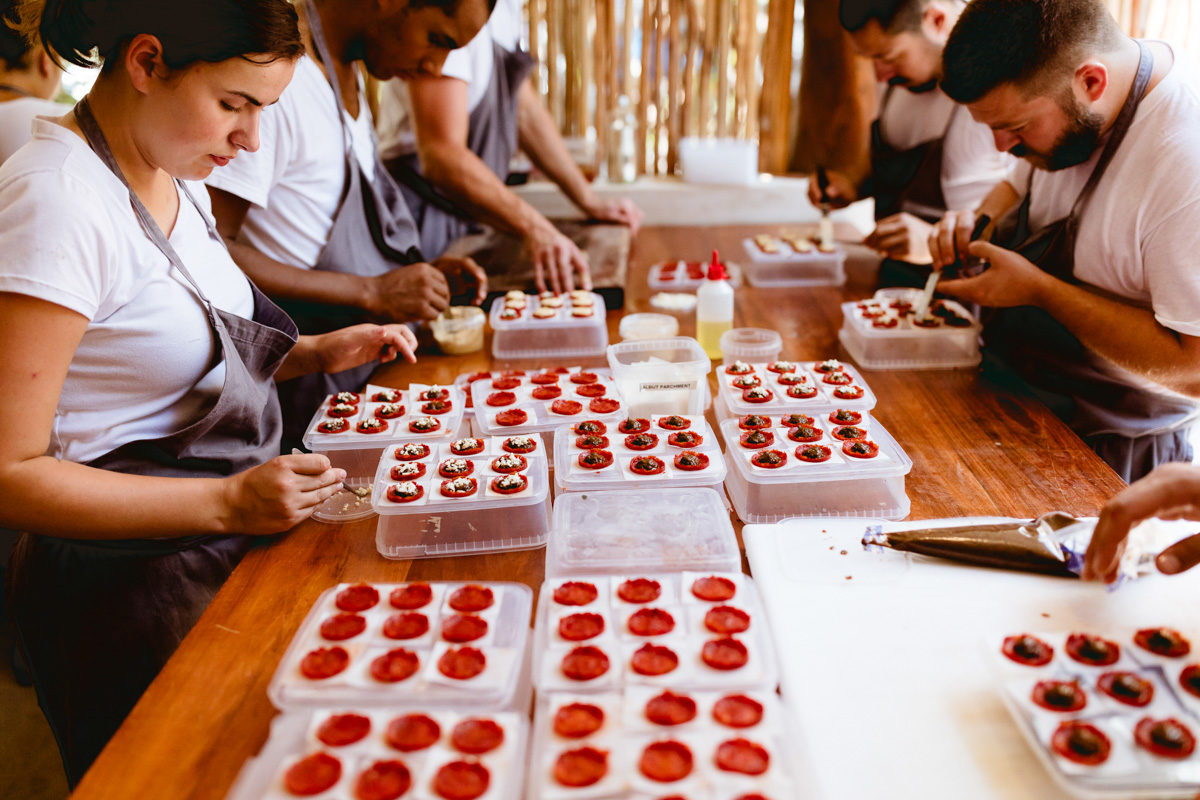
Our focus was also to keep everyone moving around the kitchen, so that no one person was ever stuck in a section or doing one job. At Noma, we focus on doing all the hard preparations together, that way no one ever feels left out. It was important to make sure that if someone wasn’t working in one area to move them around until they find a place where they do.
Tell us more about being Mexican American and what it means to you.
“Where are you from?” is one of the most complicated questions I would get asked in Europe. For me there are two answers: “I am from San Diego and Tijuana” or “I am Mexican and American”; I feel like only people from the border can understand that.
Yes, I was born in San Diego, but I was raised in both Tijuana and San Diego. I have family in both cities that allow me to connect to both cultures. So, after years of fighting my status as either Mexican or American depending on which side of the border I stood on, I learned that I am simply a border kid – a ‘fronterizo’. I came to realize this after long talks with chefs from Tijuana and San Diego, and meeting people from border towns from all over the world. This has definitely helped me connect with a lot more people in my travels.
Most of the ingredients that we used during Noma Mexico are considered rare even for everyday people living in Mexico. Meeting people from small communities here, discovering traditions and even climates that I had no idea existed in Mexico, has all just made me prouder when I say I am from Mexico.
What’s next for you?
When the pop-up ended, all I knew was that I had to travel throughout Mexico to discover, taste, and learn. To say that we have many regional cuisines here in Mexico is a massive understatement. I have dedicated the last two months traveling throughout some of the most culinary rich areas in Mexico, focusing on endemic ingredients and cuisine. One could literally spend a lifetime studying them all, and that’s what I have decided to do.
Up until Noma Mexico I had been living in Europe for 5 years. I am lucky enough to have had a boss/mentor, René Redzepi, who is also in love with Mexico and providing his support as I enter this new period of my career. I am beyond excited to announce that I have partnered with Nick Kendall, of the Colibri group, to launch two exciting concepts.
NATAL: Cocina de Tierra, a concept that will be focusing on precolonial Mesoamerican cuisine, techniques, and ingredients. Using as many native seeds, grains, nuts, flora, and fauna as possible. Little to no utensils will be used, guests will be encouraged to eat with their hands. Many dishes at NATAL will be intended to be finished by dipping or smearing the remaining sauce or cooking juices from the plate, an action that is so embedded in the DNA of Mexican cuisine. Dishes will be paired with a selection of native alcoholic beverages such as tepache, hydromiel (honey mead), pulque, mezcal, sotol, and pox. There will be no chairs or tables, at least not in a conventional way, as the setting will resemble personal experiences that we’ve had in small indigenous communities.
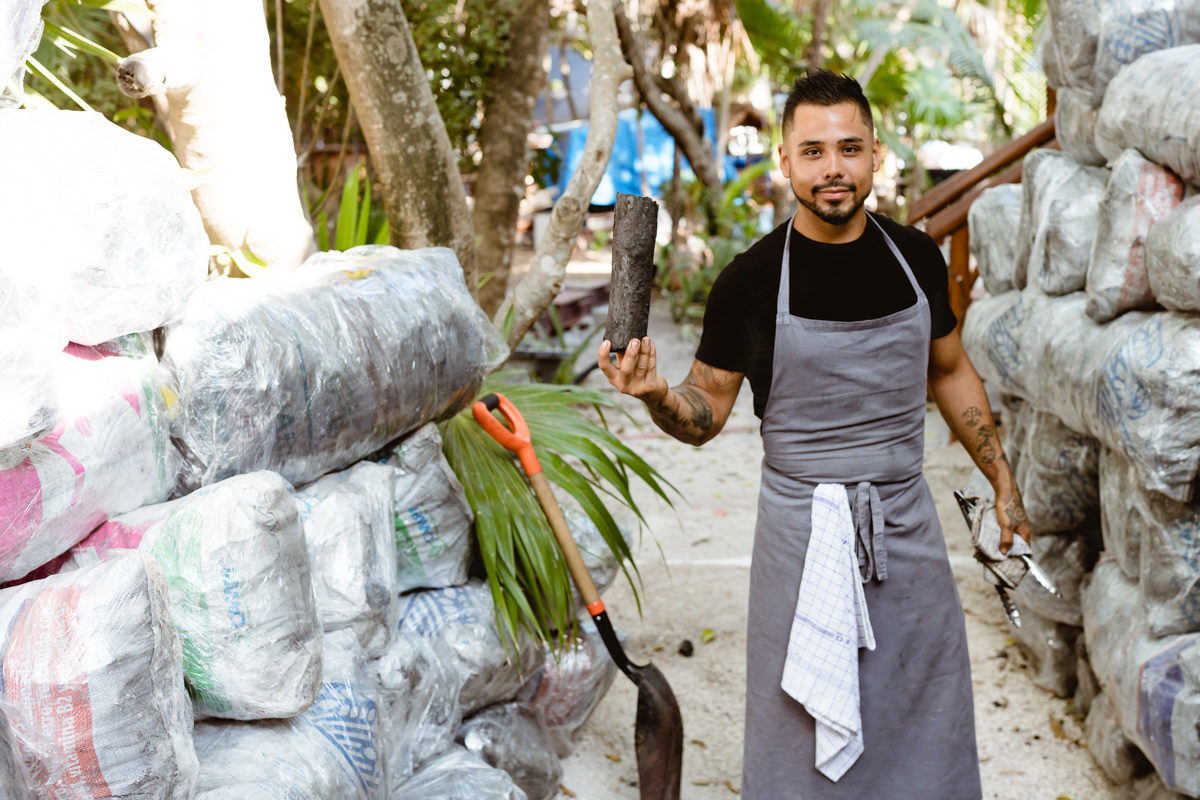
Wood fire cooking will dominate the menu. We will find inspiration from native communities all throughout the country, inviting them to share their traditions and cook alongside us. We hope that this project will allow us to showcase the diversity of culture and cuisine that Mexico has to offer, as well as helping maintain Mexican traditions that unfortunately are slowly becoming extinct. We are proud to be working with key organizations in Mexico that will help us achieve these goals. The design will be executed by La Metropolitana in Mexico City, the same team that helped us design the Noma Mexico space.
In parallel to our culinary venture, EMBERNEST, our second concept will allow you to immerse yourself in the jungle through ancient forms of shelter and living inspired by Mayan ruins. Embernest will be a casual food venue that will be open during the day on a beachfront featuring fresh and exotic product from Tabasco and the Yucatan Peninsula. The prized agriculture from this region will manifest itself in ceviches, tacos, and tostadas to name a few. Proteins will be slow-cooked over open fire varying from rotisseries, wood oven and grills.
I want both projects to serve as a way for us to capture guest curiosity and encourage them to travel deeper into Mexico. Becoming a bridge that connects them to the same communities that we are working so hard to represent.
Both NATAL and EMBERNEST, will be launching in Tulum 2018.

